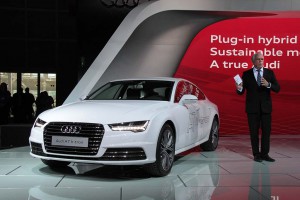
Audi's A7 h-tron Sportback Quattro may be the best of both possible green worlds: a plug-in hybrid that uses a hydrogen fuel cell.
There’s a war of words underway between proponents of battery power and those who think the fuel-cell is the future of green technology. Audi is suggesting both might find common ground in their effort to replace the conventional internal combustion engine.
The luxury arm of Volkswagen AG used the Los Angeles Auto Show to reveal its unusual A7 h-tron Sportback Quattro. The coupe-like sedan pairs a fuel-cell stack with a plug-in hybrid system to create a vehicle that produces zero emissions yet also can deliver sporty performance.
The show car is “a bold statement for the future of sustainable mobility,” proclaimed Ulrich Hackenberg, the Audi board member overseeing technical development.
A fuel-cell stack is a device that combines compressed hydrogen with oxygen from the air to produce a stream of water vapor – and a flow of current. That, in turn, can be used to run the same sort of electric motors used in a more familiar electric vehicle. As a result, a battery system can readily be plugged into the system, as well.
In the case of the Audi A7 h-tron, that means an 8.8 kilowatt-hour lithium-ion pack that, according to Hackenberg, can be recharged in as little as two hours using a 220-volt charger. The four hydrogen tanks – which hold 130 liters of the lightweight can — can meanwhile be refilled in as little as five minutes, more in line with tanking up a regular gas or diesel-powered vehicle.
There are a number of potential advantages to the combination. For one thing, neither the fuel cell stack nor the plug-in system need to be as large as they otherwise would be powering the vehicle alone. Together, however, they make 230 horsepower and 400 pound-feet of torque which can launch the coupe-like sedan from 0 to 60 mph in 7.8 seconds.
Performance has been an issue of concern with both hydrogen and battery cars – though the reality is that electric motors can develop incredible off-the-line torque given enough juice – as Tesla has shown. Its newest version of the Model S is expected to yield supercar-like launch time of just over three seconds.
For its part, Audi has been probing a variety of alternative propulsion technologies, including standalone plug-in hybrid systems it plans to use in a number of different models, including the new A3 line. It has also begun marketing in Europe a natural gas vehicle that can use a unique, “designer” fuel it is producing through the use of windpower.
But Audi isn’t alone in exploring the potential of hydrogen. In fact, its sibling Volkswagen brand revealed a fuel-cell-powered model at the LA Auto Show, as did a number of other makers. Toyota, for its part, showed the Mirai, the hydrogen car that will go on sale in Japan next month, and in the U.S. next year.
(BMW’s i3 captures Green Car of the Year Award. For more, Click Here.)
Honda has delayed until 2016 the launch of its own new fuel-cell vehicle. But it announced at the show that it will commit nearly $15 million to help build a hydrogen infrastructure in California.
(Click Here for details about the F-150 an i8 being named Innovation Vehicle awards.)
That is, in fact, one of the biggest challenges for fuel-cell proponents. There currently exist only a handful of hydrogen fueling stations, most in Southern California, which is why Toyota, Honda and Hyundai – which launched its Tucson Fuel Cell Vehicle last summer – are limiting initial sales there.
(To see more about the Mini’s new CitySurfer, Click Here.)
One of the possible advantages of pairing a fuel-cell with a plug-in hybrid system is that it could keep going even without a hydrogen source, at least as long as there was a recharging system nearby.
Whether Audi will actually put a version of the A7 h-tron into production remains to be seen, but with growing interest in alternative fuels, the maker seems likely to go with some form of hydrogen power in the future.
